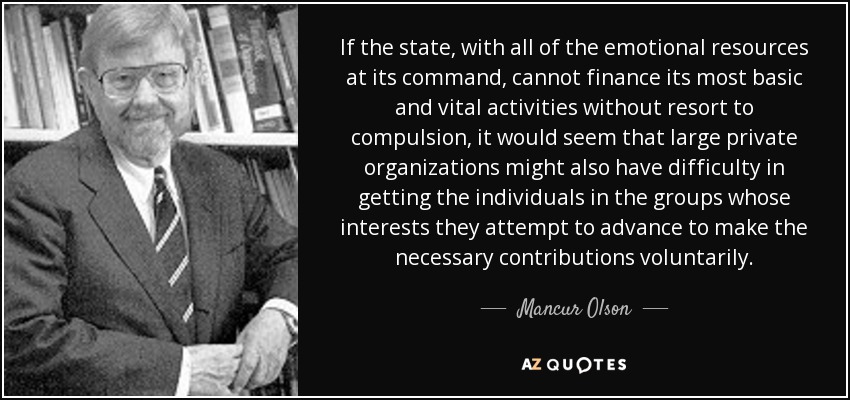A Crash in Slow Motion: Blockchain, Mancur Olson and the Logic of Collective Action
If you’re into blockchain, it’s unlikely you’ve heard of Mancur Olson. Yet his importance to the field is unmatched by any other economist in the latter half of the twentieth century.
An American born into the Great Depression, Mancur Olson was studying at Harvard in the 1950s when he started working on the economics of unions. If you’ve ever heard people complain about the way some groups successfully lobby for policies that enrich them while making everyone else worse off, then you’ve wandering into Olson territory. As an economist, what bothered Olson was the fact that most people don’t act to defend their collective economic interests, even when significant amounts of money are at stake. The issues he explored became known as “collective action” problems because they involved market pressures that disinclined individuals from acting together to fund shared interests, shared interests like the existence of a public blockchain network that keeps nodes from privatizing transaction flows and preserves the trustless and open properties of the network.
If it seems strange that blockchainers don’t talk about these problems, it’s probably because Satoshi Nakamoto never addressed them, and may not have known they existed. Whatever the reason for his omission, conventional wisdom in the space continues to reflect Satoshi’s belief that economics are straightforward: whichever nodes collect transaction fees will pay for the network. Ask for more details from someone in this frame of mind and you’ll be told that the “invisible hand” will sort out the details. After all, if someone is making money from the network then surely they will be incentivized to support it!
The argument is seductive because it feels like common sense: surely people will do things that benefit them financially? Except that this is theoretically and empirically wrong. As Olson pointed out in The Logic of Collective Action, a revised version of his doctoral dissertation which changed the course of at least three major intellectual fields (economics, political science and sociology), when participants have the option of not contributing, then the most likely outcome is the most counterintuitive: that no-one will pay for the network at all, even if it would be beneficial to everyone to have it around. As Olson described the problem:
Unless the number of individuals in a group is quite small, or unless there is coercion or some other special device to make individuals act in their common interest, rational, self-interested individuals will not act to achieve their common or group interests. In short, even if all of the individuals in a large group are rational and self-interested, and would gain if, as a group, they acted to achieve their common interest or objective, they would still not voluntarily act to achieve that common or group interest.
It is one of the deeper ironies of the blockchain space that most of the people who believe that “transaction fees will pay for the network” self-identify as libertarians. If what they believed was in fact true — if individuals funded “public goods” just because they stood to benefit financially — then free market capitalism could by definition not exist: firms would voluntarily restrict output to keep prices high and secure monopolistic profits. Only an inept individual would do what firms empirically do in competitive markets: produce goods until their marginal revenue meets their marginal cost of production, flooding the market with supply and lowering the average sales price per unit in a way that reduces both their own income as well as that of their industry peers. Capitalism as we know it would cease to exist in this world, as would the State given the lack of any need to rely on coercion or violence to collect taxes for the provision of public services.
So what is Mancur Olson’s place in the field? Viewed dispassionately, Olson is the economic counterpart to Leslie Lamport, who identified and solved the Byzantine Generals Problem in 1982. The reason they are parallel figures is that they came the closest to eliminating (in isolation) the problems that Bitcoin would claim to provide with a unified solution: a public network powered by a distributed consensus mechanism. Both figures were “surpassed” by Satoshi in his provision of the Bitcoin solution, and if Olson is less of a household name than Lamport in the circles outside their respective fields, it is likely because Olson died before being given the Riksbank Prize (i.e. Nobel Memorial Prize in Economics) whereas Lamport lived long enough to be awarded the Turing Award (i.e. Nobel Prize of Computing).
So why exactly does everyone focus on Leslie Lamport and totally overlook Mancur Olson? Why does no-one in the scaling debate think to look into what economics actually says about the ways in which free markets can successfully fund non-excludable public goods? One reason is the prevalence of technologists who simply assume that data structures are economic primitives. In the field of blockchain decentralization has become a panacea that is simply assumed to deliver a desired set of behaviors, such as non-excludability and open access and censorship resistence on the network layer. Few realize what Olson saw: that the incentive structure of the market is what determines the degree of concentration in any network, not the ability of its technical substructure to support distributed communications.
As someone who used to teach economics and game theory at Berkeley, one thing that has been bothering me for quite a while is — where are the blockchain academics who might even think to ask these questions? When one thinks of prominent people in the field, the names that come to mind are Emin Gun Sirer, David Chaum and of course Satoshi Nakamoto. Is the field really so crowded with computer science and distributed systems types that no-one is even aware that there are entire subdisciplines in Economics and Political Science that have spent decades frustrated by the economic problem Bitcoin alleges it solves? I sometimes wonder if the reason Silicon Valley is doing so poorly at “fixing” blockchain is its lack of awareness as to what the underlying problems actually are.
I suspect in the next few years we will see a bright economics student throw off the intellectual stupor that clouds the field and bring economics back to blockchain. In the meantime, I’d highly recommend The Logic of Collective Action to anyone curious about how the economic tensions in various blockchain networks will be resolved. Among Olson’s more percipient observations is that collusion and closure are the universal solutions to this problem. Saito takes a different approach, but it is interesting to think about real economics as we see what is happening in the Bitcoin and Ethereum ecosystems at scale, both of which have seen a collapse in the “group size” supporting their network, and the emergence of outsized corporate players (Calvin Ayre, Joe Lubin, et alii). Collusion and centralization. And once the block reward is smaller? Monopoly economics.




